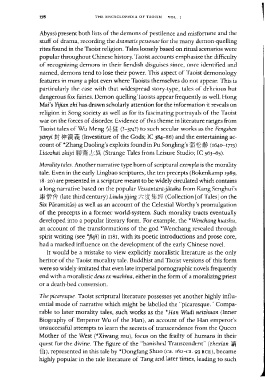Page 218 - The Encyclopedia of Taoism v1_A-L
P. 218
THE ENCYCLOPEDIA OF TAOISM VOL. I
Abyss) present both lists of the demons of pestilence and misfortune and the
stuff of drama, recording the dramatis personae for the many demon-quelling
rites found in the Taoist religion. Tales loosely based on ritual scenarios were
popular throughout Chinese history. Taoist accounts emphasize the difficulty
of recognizing demons in their fiendish disguises since, once identified and
named, demons tend to lose their power. This aspect of Taoist demonology
features in many a plot even where Taoists themselves do not appear. This is
particularly the case with that widespread story-type, tales of delicious but
dangerous fox-fairies. Demon-quelling Taoists appear frequently as well. Hong
Mai's Yijian zhi has drawn scholarly attention for the information it reveals on
religion in Song society as well as for its fascinating portrayals of the Taoist
war on the forces of disorder. Evidence of this theme in literature ranges from
Taoist tales of Wu Meng R: 5L (?-374?) to such secular works as the Fengshen
yanyi H;f$ m ~ (Investiture of the Gods; IC 384-86) and the entertaining ac-
count of *Zhang Daoling's exploits found in Pu Songling's rnJtt~ (1640-1715)
Liaozhai zhiyi I(lj~. L ~ (Strange Tales from Leisure Studio; IC 563-65).
Morality tales. Another narrative type born of scriptural exempla is the morality
tale. Even in the early Lingbao scriptures, the ten precepts (Bokenkamp 1989,
18-20) are presented in a scripture meant to be widely circulated which contains
a long narrative based on the popular Vessantara-jataka from Kang Senghui's
~1'!"1f"r (late third century) Liudujijing f\ Ht ~*:~ (Collection [of Tales] on the
Six Paramitas) as well as an account of the Celestial Worthy'S promulgation
of the precepts in a former world-system. Such morality tracts eventually
developed into a popular literary form. For example, the *Wenchang huashu,
an account of the transformations of the god *Wenchang revealed through
spirit writing (see *fuji) in U81, with its poetic introductions and prose core,
had a marked influence on the development of the early Chinese novel.
It would be a mistake to view explicitly moralistic literature as the only
heritor of the Taoist morality tale. Buddhist and Taoist versions of this form
were so widely-imitated that even late imperial pornographic novels frequently
end with a moralistic deus ex machina, either in the form of a moralizing priest
or a death-bed conversion.
The picaresque. Taoist scriptural literature possesses yet another highly influ-
ential mode of narrative which might be labelled the "picaresque." Compa-
rable to later morality tales, such works as the * Han Wudi neizhuan (Inner
Biography of Emperor Wu of the Han), an account of the Han emperor's
unsuccessful attempts to learn the secrets of transcendence from the Queen
Mother of the West (*Xiwang mu), focus on the frailty of humans in their
quest for the divine. The figure of the "banished Transcendent" (zhexian ~I§J
{W), represented in this tale by *Dongfang Shuo (ca. 160-ca. 93 BCE), became
highly popular in the tale literature of Tang and later times, leading to such

